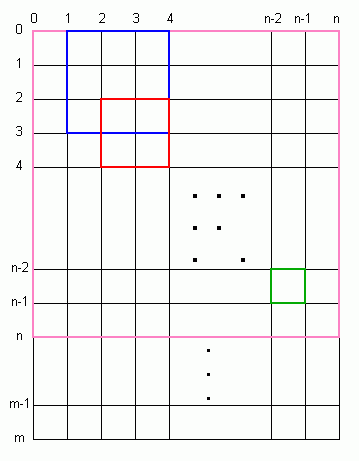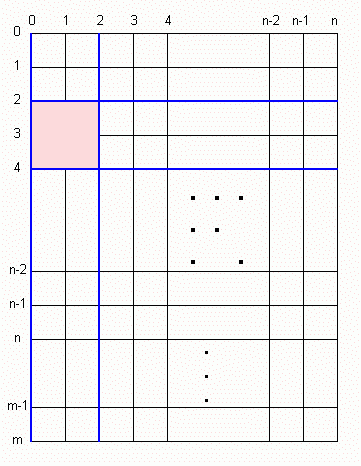| |||
| Math Central | Quandaries & Queries |
|
Question from bridget, a student: Explain how many squares there are on a board measuring 4 by 4 units, |
Bridget, we have two responses for you:
Bridget,
it is often worth your while to look into our database (use the Quick Search) for some of
your questions. There's a comment on a more general problem than
yours
mathcentral.uregina.ca/QQ/database/QQ.09.06/tania1.html
Penny
Hi Bridgit.
After looking at Penny's reply to Tania (see the link above), I thought of another way of visualizing the same problem.
Let's consider an m by n grid of squares.

Now to find the number of squares, we do what Penny said: start counting squares of size 1, then count squares of size 2, and so on until we get up to the smaller of m or n.
Let's say that we call the shorter side n from now on in our discussion.
You can see from the diagram on the left that I've coloured just a few of the many squares that are present here. Clearly, the largest square is n by n units, but there may be several of this large size if m > n.
So to go about this systematically, we first recognize that a square has four sides, so by choosing two vertical lines spaced x units apart and two horizontal lines spaced x units apart, we identify a single square.

For example, if we choose vertical lines 0 and 2, then x is 2. We then choose, say, horizontal lines 2 and 4. This identifies a particular square:
So the size of the square (x) ranges from 1 to n.
That means the left line ranges from 0 to n-x.
And the top line ranges from 0 to m-x.
(The right line and the bottom line are determined by the choice of the size, the left line and the top line.)
So let's look at this in more detail:
- x = 1:
- Left line: (n+1) - 1 = n possible choices.
- Top line: (m+1) - 1 = m possible choices.
- Total number of size 1 squares: n
 m.
m.
- x = 2:
- Left line: (n+1) - 2 = n - 1 possible choices.
- Top line: (m+1) - 2 = m - 1 possible choices.
- Total number of size 2 squares: (n - 1)
 (m - 1).
(m - 1).
- x = 3:
- Left line: (n+1) - 3 = n - 2 possible choices.
- Top line: (m+1) - 3 = m - 2 possible choices.
- Total number of size 3 squares: (n - 2)
 (m - 2).
(m - 2).
- and so on, until finally x = n:
- Left line: (n+1) - n = 1 possible choice.
- Top line: (m+1) - n = m - n + 1 possible choices.
- Total number of size n squares: (m - n + 1).
So the total number of squares is the sum of all this:

If we multiply this out, we get:

And then let's group the terms and break the summation into three parts:

The rest is easy. You probably know already these three standard sums:
 |
 |
 |
So you can substitute these in.
For your particular question Bridget, n = m = 4, so we have
( (4)(4) + 4 + 4 + 1)(4) - (4 + 4 + 2) (4) (4 + 1) / 2 + (4)(4 + 1)(2(4) + 1) / 6
100 - 100 + 30 = 30 squares.
Something very curious happened here! The first two of the three parts cancelled each other out! This always works when n = m, an assumption we didn't make in our general solution, but since you started with a 4 by 4 square, it makes sense that the answer for an n by n square is just
![]()
In other words, the total of all the squares in a square is the sum of all the squares ! ![]()
LOL,
Stephen La Rocque.
 |
||
Math Central is supported by the University of Regina and The Pacific Institute for the Mathematical Sciences.